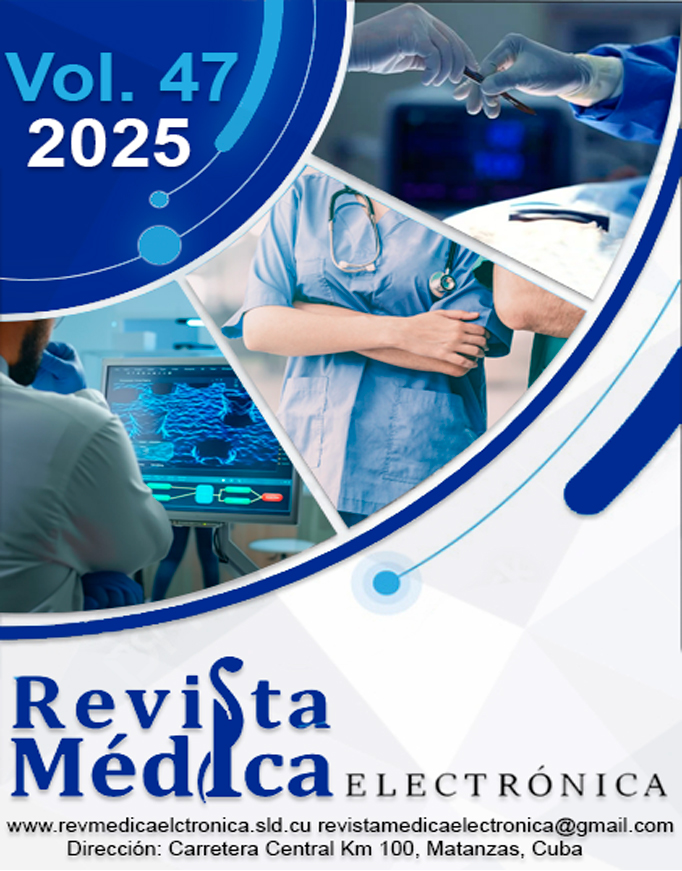Psychomotor strategy to enhance strength/coordination in children with Down syndrome
Keywords:
psychomotor strategy, strength/coordination, Down syndromeAbstract
Introduction: Down syndrome involves various motor limitations, which must be attended professionally through different areas of intervention. Hence, it is important to diagnosing and implementing optimal motor strategies.
Objective: To evaluate the effects of a psychomotor strategy to enhance strength /coordination in children with Down syndrome.
Methods: A mixed (pretest/posttest) study involving a sample of 20 children (5-6 years old) with Down syndrome, from a motor strategy implemented for 12 weeks. It is evaluated in two moments of the implementation of the intervention proposal with several indicators of strength/coordination, through six assessment tests.
Results: The study indicators showed in all cases significant improvements in favor of the posttest (p<0.05), and included hand-eye coordination (pretest: 2.1 points; posttest: 3.3 points. +1.2); throwing and catching skills (pretest: 2.3 points; posttest: 3.4 points. +1.1); motor coordination circuit (pretest: 2.0 points; posttest: 3.2 points. +1.2); ball pushing (pretest: 1.9 points; posttest: 3.0 points. +1.1); arm flexion (pretest: 2.2 points; posttest: 3.3 points. +1.1); and vertical jump (pretest: 2.0 points; posttest: 3.1 points. +1.1).
Conclusions: The structured, playful, and adaptive psychomotor strategy for enhancing motor development in terms of strength/coordination in children with Down syndrome was effective. This strategy is a valuable tool for professionals in special education, rehabilitation and psychomotricity, and in general health, while contributing to improve life quality and overall well-being of this population.
Downloads
References
1. Startin CM, D’Souza H, Ball G, et al. Health comorbidities and cognitive abilities across the lifespan in Down syndrome. J Neurodev Disord. 2020;12(1):4. DOI: 10.1186/s11689-019-9306-9.
2. Marini I, Fleming AR, Bishop M, et al. The psychological and social impact of chronic illness and disability. New York: Springer Publishing; 2023.
3. Jain PD, Nayak A, Karnad SD, et al. Gross motor dysfunction and balance impairments in children and adolescents with Down syndrome: a systematic review. Clin Exp Pediatr. 2021;65(3):142-9. DOI: 10.3345/cep.2021.00479.
4. Asqui Luna JE, León Sinche JC, Santillán Obregón RR, et al. Influencia de la teoría de las inteligencias múltiples en la educación física: estudio de casos. Rev Cubana Invest Bioméd [Internet]. 2017 [citado 15/02/2025];36(3). Disponible en: http://scielo.sld.cu/scielo.php?pid=S0864-03002017000300012&script=sci_arttext&tlng=pt
5. Alesi M, Giustino V, Gentile A, et al. Motor coordination and global development in subjects with down syndrome: The influence of physical activity. J Clin Med. 2022;11(17):5031. DOI: 10.3390/jcm11175031.
6. Miraflores Gómez E, Rojas Vidaurre IP. La psicomotricidad vivenciada de Aucouturier como mejora del retraso madurativo motor en niños de 4 años. Retos. 2023;50:737-45. DOI: 10.47197/retos.v50.98869.
7. Mamani-Jilaja D, Laque-Cordova GF, Macedo-Atamari JT, et al. Psicomotricidad, desarrollo infantil y pruebas psicomotoras: un análisis de la investigación científica en Scopus. Retos. 2025;65:377-87. DOI: 10.47197/retos.v65.113055.
8. Calero Morales S, Garzón Duque BA, Chávez Cevallos E. La corrección-compensación en niños sordociegos con alteraciones motrices a través de actividades físicas adaptadas. Rev Cubana Salud Pública [Internet]. 2019 [citado 15/02/2025];45(4). Disponible en: http://scielo.sld.cu/scielo.php?script=sci_arttext&pid=S0864-34662019000400004
9. Rodríguez Torres AF, Naranjo Munive JE, Merino Alberca WV, et al. Adaptaciones curriculares en la enseñanza para alumnos con problemas respiratorios. Rev Cubana Med Gen Integr [Internet]. 2018 [citado 15/02/2025];33(4). Disponible en: https://revmgi.sld.cu/index.php/mgi/article/view/717
10. Salazar Quinatoa M, Calero Morales S. Influencia de la actividad física en la motricidad fina y gruesa del adulto mayor femenino. Rev Cubana Inv Bioméd [Internet]. 2018 [citado 15/02/2025];37(3). Disponible en: http://www.revibiomedica.sld.cu/index.php/ibi/article/view/127/html
11. Medrano Gómez AA, Vivas Jácome AL, Criollo Gualotuña WP, et al. Diagnóstico del nivel de coordinación espacial y rítmica en la asignatura de aeróbicos. Lect educ fís deportes [Internet]. 2015 [citado 15/02/2025];20(213). Disponible en: https://www.efdeportes.com/efd213/coordinacion-espacial-y-ritmica-en-aerobicos.htm
12. Hansen E, Nordén H, Ohlsson ML. Adolescents with intellectual disability (ID) and their perceptions of, and motivation for, physical activity and organised sports. Sport Educ Soc. 2023;28(1):59-72. DOI: 10.1080/13573322.2021.1969909.
13. Roso-Moliner A, Gonzalo-Skok O, Villavicencio-Álvarez VE, et al. Analyzing the Influence of Speed and Jumping Performance Metrics on Percentage Change of Direction Deficit in Adolescent Female Soccer Players. Life. 2024;14(4):466. DOI: 10.3390/life14040466.
14. Kelly LE. Adapted physical education national standards. 3rd ed. Illinois: Human Kinetics Publishers; 2020.
15. Iorga A, Jianu A, Gheorghiu M, et al. Motor coordination and its importance in practicing performance movement. Sustainability. 2023;15(7):5812. DOI: 10.3390/su15075812.
16. Argüello Pazmiño SM, Díaz Cevallos AC, Hidalgo MI, et al. Estudio de la fiabilidad del test de Fukuda en distintos ambientes y rotaciones angulares. Rev Cubana Enfermer [Internet]. 2019 [citado 15/02/2025];34(3). Disponible en: https://revenfermeria.sld.cu/index.php/enf/article/view/2982
17. Changiz T, Amouzeshi Z, Najimi A, et al. A narrative review of psychomotor abilities in medical sciences: Definition, categorization, tests, and training. J Res Med Sci. 2021;26(1):69. DOI: 10.4103/jrms.JRMS_965_19.
18. Calero-Morales S, Vinueza-Burgos GdC, Yance-Carvajal CL, et al. Gross Motor Development in Preschoolers through Conductivist and Constructivist Physical Recreational Activities: Comparative Research. Sports. 2023;11(3):61. DOI: 10.3390/sports11030061.
19. Roz-Faraco CC, Linares Baeza LC, Martínez-Heredia N. Evidence of the application of didactics in the classrooms, after training on fine psychomotricity provided to early childhood education teachers. Retos. 2022;45:124-37. DOI: 10.47197/retos.v45i0.88886.
20. Game Mendoza K, Vinueza Burgos GdC, Icaza Rivera DP, et al. Efectos de las estrategias colaborativas en el proceso académico de enseñanza-aprendizaje de voleibolistas prejuveniles. Retos. 2024;61:1172-83. DOI: 10.47197/retos.v61.109363.
21. Campos-Campos K, Monsalves Cruces G, Paredes Marcelo M, et al. Importancia de la estimulación temprana para el desarrollo motor en niños con síndrome de Down: Una revisión sistemática. Rev peru cienc act fís deporte [Internet]. 2021 [citado 15/02/2025];8(3):10. Disponible en: https://rpcafd.com/index.php/rpcafd/article/view/152
22. Lakkala S, Uusiautti S, Kyrö-Ämmälä O, et al. Students' Social Self-Image and Engagement with Studies within the Classroom: A Qualitative Multimethod Research on Teachers' Pedagogical Activities in Inclusive Education. Int J Whole Sch [Internet]. 2020 [citado 15/02/2025];16(1):35-60. Disponible en: https://research.ulapland.fi/en/publications/students-social-self-image-and-engagement-with-studies-within-the
23. Calero-Morales S, Villavicencio-Alvarez VE, Flores-Abad E, et al. Pedagogical control scales of vertical jumping performance in untrained adolescents (13–16 years): research by strata. PeerJ. 2024;12:e17298. DOI: 10.7717/peerj.17298.
24. Hauck JL, Felzer-Kim IT, Gwizdala KL. Early movement matters: Interplay of physical activity and motor skill development in infants with Down syndrome. Adapt Phys Activ Q. 2020;37(2):160-76. DOI: 10.1123/apaq.2019-0012.
25. Yunus FT, Widagda IM, Isma R. The effect of sensory-motor virtual reality on balance in children with clinical Down syndrome. Diponegoro Med J. 2024;13(2):66-71. DOI: 10.14710/dmj.v13i2.42137.
26. Potosí-Moya V, Paredes-Gómez R, Calero-Morales S. Effects of Nordic Exercises on Hamstring Strength and Vertical Jump Performance in Lower Limbs Across Different Sports. Appl Sci. 2025;15(10):5651. DOI: 10.3390/app15105651.
27. Sabat C, Arango P, Tassé MJ, et al. Different abilities needed at home and school: The relation between executive function and adaptive behaviour in adolescents with Down syndrome. Sci Rep. 2020;10(1):1683. DOI: 10.1038/s41598-020-58409-5
28. Airasca DA, Giardini HA. Actividad física, salud y bienestar. Buenos Aires: Nobuko; 2022.
29. Singal N, Mbukwa-Ngwira J, Taneja-Johansson S, et al. Impact of Covid-19 on the education of children with disabilities in Malawi: reshaping parental engagement for the future. Int J Incl Educ. 2025;29(1):112-28. DOI: 10.1080/13603116.2021.1965804.
30. Trujillo Galeano A, Andrade-Garcia LA, Garcia Marin LA. Implicaciones de la práctica deportiva (fútbol) en las destrezas motoras gruesas comprometidas en adolescentes con síndrome de Down. Rev Iberoam Psicol Ejerc Deporte [Internet]. 2024 [citado 15/02/2025];19(1):75-82. Disponible en: https://dialnet.unirioja.es/servlet/articulo?codigo=9490905
Downloads
Published
How to Cite
Issue
Section
License
Copyright (c) 2025 Janeth del Pilar López-Sevilla, Nathalia Cristina Chamorro-Balseca, José Guillermo Caicedo-Merizalde , Carlos Leónidas Gutierrez-Alvarez, Manuel Gutiérrez-Cruz, Giovanny Capote-Lavandero, Amarilys Torres-Ramírez

This work is licensed under a Creative Commons Attribution-NonCommercial 4.0 International License.
All content published in this journal is Open Access, distributed under the terms of the CC BY-NC 4.0 License.
It allows:
- Copy and redistribute published material in any medium or format.
- Adapt the content.
This will be done under the following terms:
- Attribute the authors' credits and indicate whether changes were made, in which case it must be in a reasonable way.
- Non-commercial use.
- Recognize the journal where it is published.
The copyrights of each article are maintained, without restrictions.






